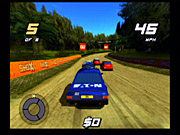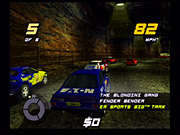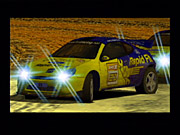Launched alongside the PlayStation 2 some two years ago, EA Sports' Big franchise has come to be widely recognized for its outrageous characters and over-the-top depictions of popular sports. From SSX Tricky to NBA Street, EA Sports Big games feature a style all their own. The latest game in this franchise, Shox, is a rally racing game that continues the Big tradition of frenzied sports action, though it's the first Big game that doesn't have any characters. There are no drivers to choose from here, and no archrivals to hold grudges against. But that doesn't mean the game lacks personality. Shox places the focus of the game squarely on its wide selection of cars and its well-designed courses, makes use of an interesting and unique racing mechanic, and presents itself in a very slick and stylish overall package. Like the last EA Sports Big game, Freekstyle, Shox can be frustrating at times, but it's yet another solid game in the short but noteworthy history of this Electronic Arts franchise.

As a racing game, Shox is particularly interesting because it doesn't feature the genre's traditional gameplay modes. While it's become commonplace to expect time trial, single race, and career modes in driving games, Shox has only one: the championship mode. Here, you'll take one of 24 officially licensed cars like the Mitsubishi Lancer Evo VII or the Lancia Stratos through 30 different races that are spread across five unique leagues. These leagues--compact, sports, turbo, power, and shox--dramatically increase in difficulty from one to the next, and they require you to place first overall to progress. Within each league, you'll find six individual courses, two for each of Shox's sand, snow, and jungle environment types, all three of which require you to adopt a unique driving style in order to cope with the different surface types. Unlike more realistic rally games, Shox pits you against five other cars, not the clock, and you'll finish the game after placing first overall in the shox league, but doing so isn't as straightforward as it might sound.

Every course in the game has three "shox zones." These are segments of the track that you are timed on and given a gold, silver, or bronze ranking within the actual race. The idea here is to earn a gold ranking in all three segments within a given racing event, and since each race consists of three laps, you'll have three opportunities to earn that ranking in each shox zone. The game will always take the fastest of the three times you post in each track's three shox zones, so there's no need to worry about losing a gold ranking that you earned in the first lap of a race, for example, after a particularly slow run in the third. There are two reasons why you'll want to earn a gold ranking in each shox zone. First, the better your shox zone segment times, the more money you'll earn. There's a prominent financial element to Shox, and you have to buy any car that you want to race with. You don't unlock cars in this game--rather, you unlock the opportunity to purchase them. Second, if you earn three gold rankings in a given race, you'll unleash a "shoxwave." This bubble of condensed air will travel slightly ahead of you on the racetrack, and if you manage to catch up to it, it'll not only give you a speed boost, but it'll also constantly feed you a steady stream of money as long as you're able to keep up with it. The shoxwave dissipates after one lap, but if you make good use of it, you can fatten up your coffers nicely. Interestingly enough, Shox, even though it's clearly an arcade-style racing game, models damage. Every time you collide with a wall on the track, a certain amount of money will be deducted from that race's total earnings, and you'll be able to see the damage on your car as well. This damage has absolutely no effect on your car's handling or performance, however.
Another noteworthy gameplay mechanic of Shox is its gambling feature. As you earn money in the game, you can purchase faster and more exotic cars in order to get a leg up on the competition. However, you can also gamble for a new car. Instead of buying a car outright, you'll be asked to place a certain amount of money on the line--usually a third of the cost of the car--and then forced to race against the car you're after. The advantage to gambling for a car is that, if you win, you'll get to keep that car at a fraction of its normal cost. If you lose, however, you'll forever lose the money that you put up to participate in that bet. What's more, the car you're racing against is always given a head start, and the later cars are especially tough to beat in a one-on-one gambling race. As you progress though Shox's five leagues, you'll find that it becomes increasingly risky to gamble, since the buy-in becomes increasingly more expensive, and the cars become increasingly faster.
But it's not just speed that determines the winner in Shox. The game's cars are measured by steering and stability rankings, in addition to speed. Obviously, none of the cars handle like their real-world counterparts, but they all feel distinct from each other. For the most part, the game's handling is precise, though you will encounter moments of frustration. This is especially true of cars with low stability, since a collision with the track walls or other cars will either spin them around to face oncoming traffic or flip them upside down. In these situations, it'll only take you a few seconds to right yourself again, but it takes even less time for the entire field to blow past you. The AI of the other cars in Shox is unforgiving, and if you make a mistake in the third lap of most any race, your chances of passing the other five cars and placing first are slim. Though, the game doesn't penalize you for racing the same event numerous times. In fact, you can keep earning money like this, so it's actually in your benefit to do so. Still, if you played Freekstyle, Shox's difficulty will likely bring on waves of déjà vu.

That aside, the rest of the game is great. The entire game, from the interface to the tracks and the car models, is extremely slick. Shox makes use of a "drama cam" and a "crash cam" that instantly provide a Matrix-like effect every time you launch off a big jump or crash with flair. Like Need for Speed: Hot Pursuit 2, though, this effect eventually gets in the way of your race, and you'll ultimately turn it off, never to turn it back on again. Still, the game has plenty of flash and minute details elsewhere. Of particular note is the lighting, which provides impressive shadows on the cars and track and reflections of the sun that will have you practically averting your eyes because of the glair. This is especially true in the game's snowy tracks, which, at the right angle, make for some of the best-looking snow-blind effects ever seen in a game. The cars themselves are modeled in a way that gives them a slightly more muscular demeanor than their real-world counterparts, and this design decision works very well in a lighthearted game like Shox. Additionally, damage and dirt become quite evident on your car model, especially toward the end of a race, when you'll note missing bumpers, scraped paint, and dented doors. What's more, if you switch to one of the game's two first-person perspectives while racing, bits of dirt and mud kicked up by cars in front of you will speckle your view.
The sound matches the high standards set by Shox's visuals. The game's soundtrack is composed of licensed house and techno beats from real-world DJs, though unlike in some European-developed racing games, these tracks are mostly upbeat and lack the typical heavy drum and bass that's crowding the genre. Many of the tracks have ambient effects like crowds cheering, rushing water, low-flying airplanes, and so on. What's more, all the engines and exhaust notes of Shox's 24 cars are completely unique, and their pitch and volume change as you switch perspectives, pass under bridges, or drive through tunnels. Though, perhaps the best showcase of the game's sound is the effect that accompanies a shoxwave. If you manage to catch up to one of these speedy bubbles, all of the race's sounds will instantly be subdued and replaced with a low-level drone. If you've ever jumped in a pool, or watched as a dazed Tom Hanks lands on the beach during the opening moments of Saving Private Ryan, then you know what this sounds like. The only sticking point with the game's sound is its announcer, who will drive you nuts with his used-car-salesman enthusiasm after only a few minutes.

Even though Shox has only a single mode of play, there's a lot to this game that might not be immediately evident. Depending on your performance in any given race, for example, you'll be able to unlock nighttime versions of all the tracks, or be able to halve the costs of gambling for certain cars. Additionally, if you earn three gold shox zone ratings in a race that you ultimately finish first in, and you do so in a specific car, you'll unlock platinum versions of some of the cars in Shox. These are souped-up variants of the normal cars in the game, with glossy paint jobs and better steering, speed, and stability ratings. Shox also supports up to four players on a split screen in two distinct modes of play. The first is a standard head-to-head mode that lets you and up to three others race against computer-controlled cars, much like Need for Speed's "the pack" mode. The second is called mayhem, and it's basically a slight twist on capture-the-flag. Here, you steal the flag by touching the car that is "it." The player in possession of the flag when the timer runs out wins the match.
Its solid execution of some unique racing mechanics and its extremely slick presentation make Shox another recommendable game in EA Sports' successful Big franchise. It has a lot of flash, but it backs it up with a good amount of substance. Some of its control issues and the overly aggressive AI can make the game frustrating at times, and it would have been nice if EA had taken similar feedback on Freekstyle to heart, but you'll ultimately find that Shox's strong points outweigh its shortcomings.